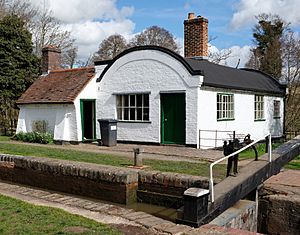Lengthsman facts for kids
A Lengthsman was a person who looked after a specific "length" of road, canal, or railway. The idea started way back in the Middle Ages and Tudor times, even during the War of the Roses. Their main job was to keep their section neat, tidy, and easy to use. This often included marking boundaries. Later, lengthsmen also worked on canals and railways from the very beginning.
On land, a lengthsman might be in charge of a few miles of road between villages, especially in common areas. They were first hired by local lords and later by parish councils. Their duties included keeping grass and weeds down on the sides of roads, clearing drainage ditches, and fixing fences. They also picked up litter and sometimes even planted wild flowers.
Lengthsmen Today
Lengthsmen are still employed by some local councils today, though it's not as common as it used to be. Their tasks in the 21st century often involve looking after central green areas or commons, and dealing with small drainage issues. For example, Shenstone Parish Council in Staffordshire has employed a lengthsman since 2018. This person works two days a week to keep the areas of Shenstone, Stonnall, and Little Aston clean. They trim verges, maintain ditches, and repair things like bus shelters, benches, fences, and footpaths. This approach has been very effective and faster than hiring outside companies. Riccall Parish Council in North Yorkshire also employs a lengthsman for routine village maintenance.
The idea of lengthsmen was also used by the National Parks of England and Wales. They used volunteers with special rural skills for projects like hedge-laying (a traditional way of managing hedges) and building walls.
Lengthsmen on Canals

Lengthsmen were very important for the English canal system from when it first started in the late 1700s. They were responsible for sections of the towpath (the path next to the canal where horses would pull boats). If there wasn't a lock-keeper nearby, they also looked after the locks and the areas around them. Many early lengthsmen lived in small, isolated cottages. If their cottage was near a lock, they might also have had lock-keeper duties. This included managing water levels and controlling weirs (small dams).
Canal lengthsmen also had to repair and maintain the banks of their section of the canal. This meant cutting reeds and other plants. They would also tread "puddle clay" into weak or leaky sections of the bank to stop water from escaping.
The Thames and Severn Canal even built special circular cottages with three floors just for their lengthsmen. Five of these unique cottages, built in the 1790s, are still standing today. One example is the cottage at Lowsonford, shown in the picture.
Grand Union Canal Projects
In the winter of 2015-2016, a volunteer lengthsman recorded the exact GPS locations of milestones along the Grand Union Canal. This was part of a "Special Lengthsman Project." About forty of these milestones also had a daffodil bulb planted next to them, to make them easier to find in the future.
Today, active volunteer teams work as lengthsmen on parts of the Grand Union Canal. For example, the "Towpath Taskforce" at Croxley Green works with the Canal & River Trust to help maintain the towpaths.

